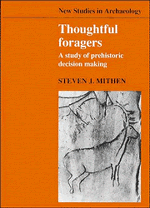Book contents
- Frontmatter
- Contents
- List of figures
- List of tables
- Preface
- 1 Introduction
- PART ONE LEARNING FROM THE PRESENT
- PART TWO MESOLITHIC FORAGING AND SOCIETY
- PART THREE UPPER PALAEOLITHIC ART AND ECONOMY
- 7 Seeking the decision maker: faunal assemblages and hunting behaviour
- 8 Through a hunter's eyes … and into his mind?
- 9 Conclusion
- Bibliography
- Index
7 - Seeking the decision maker: faunal assemblages and hunting behaviour
Published online by Cambridge University Press: 04 August 2010
- Frontmatter
- Contents
- List of figures
- List of tables
- Preface
- 1 Introduction
- PART ONE LEARNING FROM THE PRESENT
- PART TWO MESOLITHIC FORAGING AND SOCIETY
- PART THREE UPPER PALAEOLITHIC ART AND ECONOMY
- 7 Seeking the decision maker: faunal assemblages and hunting behaviour
- 8 Through a hunter's eyes … and into his mind?
- 9 Conclusion
- Bibliography
- Index
Summary
I saw a jolly hunter
With a jolly gun
Walking in the countryside
In the jolly sun
Charles Causley, ‘I Saw a Jolly Hunter’Over the green pastures there
You shall go hunting the beautiful deer
W.H. Auden with Christopher Isherwood, ‘The Ascent of F.6’My intention in this work is to argue that a focus on the individual decision maker is the stance for developing adequate explanations in archaeology. Let me make the tentative assumption that you have found something of value in my study of Mesolithic foraging and society, that you feel my focus on individual decision making has indeed made a contribution to explaining the variability and patterning in that archaeological record, whether or not you agree with my specific arguments. However, I can hear you asking if this was so as a result simply of the particular character of those data rather than of any inherent virtue in my individualistic eco-psychological decision-making approach. Can we find the individual and use our growing understanding of decision-making processes when we have an archaeological record of a markedly different character, for instance when faunal assemblages are large and complex, deriving from ‘multiple authors’ (Gamble 1984: 239) and co-operative hunting and without the fine chronological resolution of the Mesolithic? And what if our principal problem does not immediately refer to hunting behaviour but to cognition? Does an individual decision-making approach enable us to develop our studies of, say, prehistoric art and ritual? My answer is of course an emphatic yes. To demonstrate this, I will take a step backwards from the Mesolithic to the late glacial and tackle problems posed by Upper Palaeolithic art.
- Type
- Chapter
- Information
- Thoughtful ForagersA Study of Prehistoric Decision Making, pp. 197 - 225Publisher: Cambridge University PressPrint publication year: 1990

